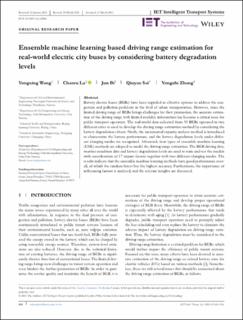| dc.contributor.author | Wang, Yongxing | |
| dc.contributor.author | Lu, Chaoru | |
| dc.contributor.author | Bi, Jun | |
| dc.contributor.author | Sai, Qiuyue | |
| dc.contributor.author | Zhang, Yongzhi | |
| dc.date.accessioned | 2022-03-08T07:54:25Z | |
| dc.date.available | 2022-03-08T07:54:25Z | |
| dc.date.created | 2021-04-29T11:01:38Z | |
| dc.date.issued | 2021-04-20 | |
| dc.identifier.citation | IET Intelligent Transport Systems. 2021, 15 (6), 824-836. | en_US |
| dc.identifier.issn | 1751-956X | |
| dc.identifier.issn | 1751-9578 | |
| dc.identifier.uri | https://hdl.handle.net/11250/2983608 | |
| dc.description.abstract | Battery electric buses (BEBs) have been regarded as effective options to address the congestion and pollution problems in the field of urban transportation. However, since the limited driving range of BEBs brings challenges for their promotion, the accurate estimation of the driving range with limited available information has become a critical issue for public transport operators. The real-world data collected from 50 BEBs operated in two different cities is used to develop the driving range estimation method by considering the battery degradation effects. Firstly, the incremental capacity analysis method is introduced to characterize the battery performance, and the battery degradation levels under different charging modes are recognized. Afterward, four types of ensemble machine learning (EML) methods are adopted to model the driving range estimation. The BEB driving data, weather condition data and battery degradation levels are used to train and test the models with consideration of 17 impact factors together with two different charging modes. The results indicate that the ensemble machine learning methods have good performance overall, of which the random forest has the highest accuracy. Furthermore, the importance of influencing factors is analysed, and the relevant insights are discussed. | en_US |
| dc.description.sponsorship | This research was supported by the JPI Urban Europe-NSFC project named SMUrTS. The project was funded by the National Natural Science Foundation of China (Grant 71961137008) and the Research Council of Norway (Grant 299078). | en_US |
| dc.language.iso | eng | en_US |
| dc.publisher | Wiley Open Access | en_US |
| dc.relation.ispartofseries | IET Intelligent Transport Systems;Volume 15, Issue 6 | |
| dc.rights | Navngivelse 4.0 Internasjonal | * |
| dc.rights.uri | http://creativecommons.org/licenses/by/4.0/deed.no | * |
| dc.subject | Battery electric buses | en_US |
| dc.subject | Ensemble machine learning | |
| dc.subject | Battery performances | |
| dc.subject | Public transport | |
| dc.subject | Driving range estimations | |
| dc.title | Ensemble machine learning based driving range estimation for real‐world electric city buses by considering battery degradation levels | en_US |
| dc.type | Peer reviewed | en_US |
| dc.type | Journal article | en_US |
| dc.description.version | publishedVersion | en_US |
| dc.rights.holder | © 2021 The Authors | en_US |
| cristin.ispublished | true | |
| cristin.fulltext | original | |
| cristin.qualitycode | 1 | |
| dc.identifier.doi | https://doi.org/10.1049/itr2.12064 | |
| dc.identifier.cristin | 1907171 | |
| dc.source.journal | IET Intelligent Transport Systems | en_US |
| dc.source.volume | 15 | en_US |
| dc.source.issue | 6 | en_US |
| dc.source.pagenumber | 824-836 | en_US |
| dc.relation.project | Norges forskningsråd: 299078 | en_US |
| dc.relation.project | National Natural Science Foundation of China: 71961137008 | en_US |

